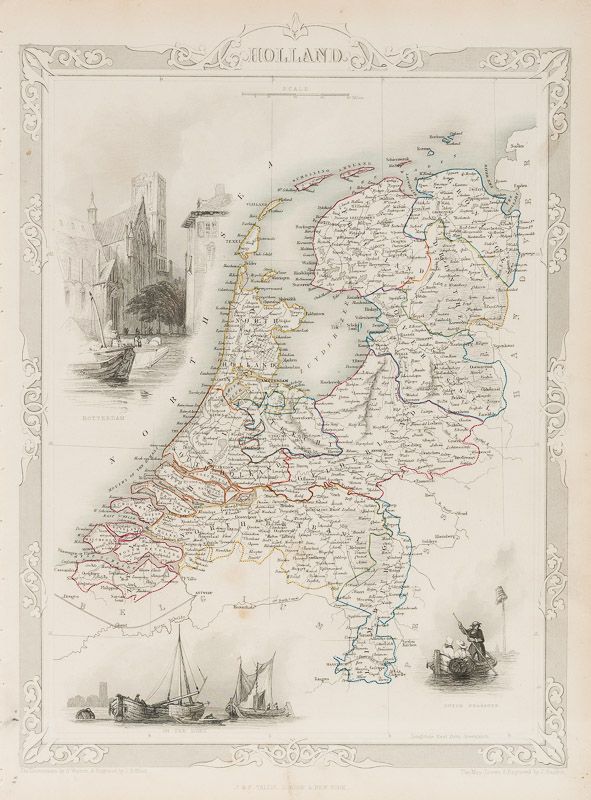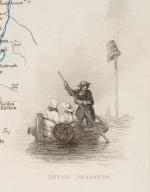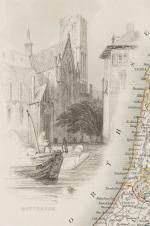Tallis, Holland - with Vignette of Rotterdam and De
Holland – with Vignette of Rotterdam and Depictions of Dutch Peasants on the Dort.
Original steel engraving / Vintage map. Drawn and engraved by John Rapkin. Partly hand-coloured. Illustrations by H. Warren and engravings by J.B. Allen. London & New York, J & F. Tallis, 1851. Plate Size: 25 cm x 35 cm. Sheet Size: 27.2 cm x 37.3 cm. Vintage 19th century map in very good condition.
Published in the Illustrated Atlas, And Modern History Of The World Geographical, Political, Commercial & Statistical, Edited By R. Montgomery Martin.
Beautiful and interesting map of Holland. The internal political sub-divisions are shown on the map, with provinces such as Gelderland, North Brabant and Groningen identified. The Netherlands are surrounded by Belgium to south and the German states of Prussia and Hanover to the east with The North Sea lapping against the Dutch in the west. The map is crowded with towns and cities such as Amsterdam, Eyndhoven that illustrate the urban and densely populated status of Holland. The railway system is included on the map also. Relief is depicted by hachuring. The rivers and lakes such as the Haarlem Meer and River Wall are also included. The Zuyder Zee can also be seen.
John Tallis (7 November 1817 – 3 June 1876) was an English cartographic publisher. His company, John Tallis and Company, published views, maps and atlases in London from roughly 1838 to 1851.
Tallis set up as a publisher with Frederick Tallis in Cripplegate in 1842; the business moved to Smithfield in 1846, and was dissolved in 1849. From 1851 to 1854 Tallis operated as John Tallis and Company. He started The illustrated news of the world and national portrait gallery of eminent personages in 1858, selling it for £1,370 in 1861; it folded in 1863. (Wikipedia)
The most important project John Tallis undertook, was the ‘Illustrated Atlas’ from 1851. The original map we offer here, was part of this exceptional Atlas and all the maps it contained are still today considered as the last reminder of an era of lavish map production. Tallis worked the project together with John Rapkin (1815-1876) and it was Rapkin’s style and talent that we have to thank for when we marvel at these maps today. What makes these maps so special is the detail of engraved vignettes that surround the map and often show indigenous scenes, people in their environment and even more so, historical buildings or historical views of towns and cities, architecture and landscape.
The project of ‘The Illustrated Atlas’ was designed to be finished just in time for the anxiously awaited “Great Exhibition of the Works of Industry of All Nations” or The Great Exhibition, sometimes referred to as the Crystal Palace Exhibition in reference to the temporary structure in which it was held, was an international exhibition that took place in Hyde Park, London, from 1 May to 11 October 1851. It was the first in a series of World’s Fairs, exhibitions of culture and industry that became popular in the 19th century, and it was a much-anticipated event.
The Great Exhibition was organized by Henry Cole and Prince Albert, husband of the reigning monarch, Queen Victoria. It was attended by numerous notable figures of the time, including Charles Darwin, Samuel Colt, members of the Orléanist Royal Family and the writers Charlotte Brontë, Charles Dickens, Lewis Carroll, George Eliot and Alfred Tennyson. Music for the opening was under the direction of Sir George Thomas Smart and the continuous music from the exhibited organs for the Queen’s procession was “under the superintendence of William Sterndale Bennett”. (Wikipedia)
- Keywords: 19.Jahrhundert · 19th Century · 19th Century Map · Cartography · Catalogue No.5 – Maps of the World · Dutch · English Channel · Europe · Holland · John Tallis Maps · Map · North Sea · Original Map · Original Maps · Original Steel Engraving · Originale Landkarte · Rare Map – Holland · The Netherlands · Travel Holland – Rare · Vintage Map · Vintage Old Map
- Language: English
- Inventory Number: 200101AG
EUR 375,--
© 2024 Inanna Rare Books Ltd. | Powered by HESCOM-Software














